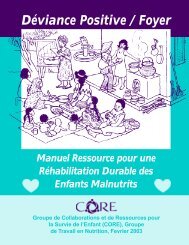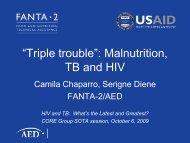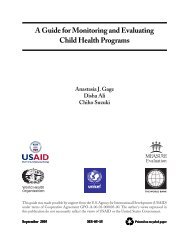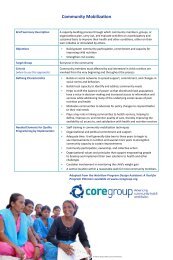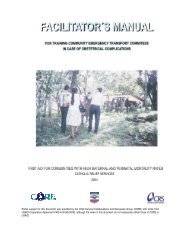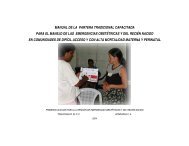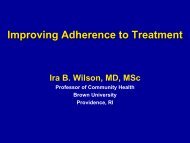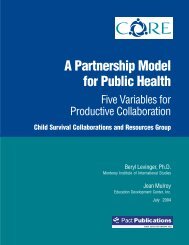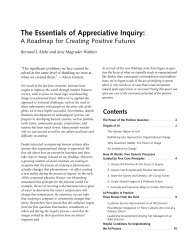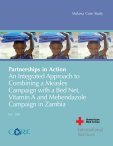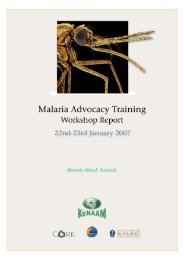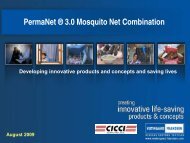Community Approaches to Child Health in Malawi: - CORE Group
Community Approaches to Child Health in Malawi: - CORE Group
Community Approaches to Child Health in Malawi: - CORE Group
You also want an ePaper? Increase the reach of your titles
YUMPU automatically turns print PDFs into web optimized ePapers that Google loves.
IV. Results<br />
In <strong>Malawi</strong>, World Relief’s 2000–2004 child survival project area reported<br />
the follow<strong>in</strong>g results at program end: Residents were far less likely <strong>to</strong> use<br />
traditional healers, people s<strong>to</strong>pped us<strong>in</strong>g bed nets for fish<strong>in</strong>g, mothers<br />
cont<strong>in</strong>ued breastfeed<strong>in</strong>g children even when pregnant, and children<br />
and pregnant women were more likely <strong>to</strong> eat eggs, high <strong>in</strong> prote<strong>in</strong> and<br />
essential micronutrients. The program’s <strong>in</strong>dependent evalua<strong>to</strong>r noted that<br />
“community norms are gradually but steadily be<strong>in</strong>g re-shaped and realigned<br />
with key messages, thereby sett<strong>in</strong>g standards for acceptable behavior.<br />
A significant number of traditional healers abandoned their practice and<br />
jo<strong>in</strong>ed the program as volunteers, isolat<strong>in</strong>g and underm<strong>in</strong><strong>in</strong>g the credibility<br />
of those who resisted.” 9<br />
Below are some highlights from the knowledge, practices and coverage<br />
(KPC) survey conducted us<strong>in</strong>g a 30-cluster methodology at the beg<strong>in</strong>n<strong>in</strong>g<br />
and end of World Relief’s child survival project:<br />
KPC Survey Highlights, World Relief <strong>Malawi</strong> <strong>Child</strong> Survival Projects<br />
2000–2004 2005–2009<br />
Basel<strong>in</strong>e F<strong>in</strong>al Basel<strong>in</strong>e Mid-Term<br />
Exclusive breastfeed<strong>in</strong>g 36% 95% 40% 84%<br />
Growth moni<strong>to</strong>r<strong>in</strong>g of children under 3 years of<br />
age (Project Area 2 <strong>in</strong>cludes children under 5)<br />
65% 97% 81% 94%<br />
Pregnant women gett<strong>in</strong>g daily iron/folate 3% 76% 85% 87%<br />
<strong>Child</strong>ren under 5 sleep<strong>in</strong>g under a treated bed<br />
net<br />
Pregnant women sleep<strong>in</strong>g under a treated bed<br />
net (Project area 2 <strong>in</strong>cludes all mothers)<br />
Pregnant women gett<strong>in</strong>g presumptive treatment<br />
for malaria with sulfadox<strong>in</strong>e-pyrimetham<strong>in</strong>e<br />
Suspected malaria cases <strong>in</strong> children under age 2<br />
were treated with<strong>in</strong> 24 hours<br />
<strong>Child</strong>ren



